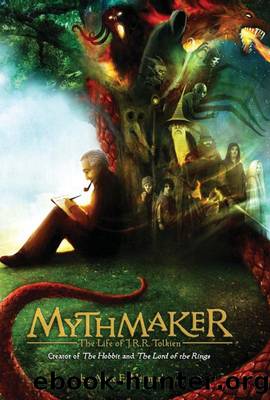Mythmaker by Anne E. Neimark;

Author:Anne E. Neimark;
Language: eng
Format: epub
Publisher: Houghton Mifflin Harcourt Publishing Company
Chapter 8
AFTER THE EVENING COALS WERE snuffed out and Edith and the children were asleep, Ronald would climb the stairs to the attic. Heâd sit on a camp bed, writing in his latest notebook. A keyhole desk was stuffed with papers and an old Hammond typewriter. It didnât matter that the next day would be crowded with lectures, that the Coalbitersâa group Ronald had formed to read Icelandic literatureâwould convene at the Edgewood Hotel, or that he had supper plans with his friend, fellow writer and lecturer C. S. Lewis. Nor did it matter that thirteen-year-old John needed to be fetched from boarding school in Berkshire or that Ronald had promised to plant tomato seeds with six-year-old Christopher; he put off sleeping to spend several hours alone in the attic, âdiscoveringâ a hobbit named Bilbo Baggins.
Hobbits, he wrote, were little folks âhalf our height,â living in elaborate underground holes in the Shire region of Middle-earth. They wore no shoes because their feet grew ânatural leathery soles and thick warm brown hair.â Fond of colorful clothes, gardens, food, and tobacco (âpipe weedâ), they were good-natured but shy. Bilbo, an ordinary hobbit, never did anything rash or unexpected. One day, however, while having tea, he was visited by thirteen dwarves and the Wizard Gandalf. Against all his objections (âWe donât want any adventures here, thank you!â), he was whisked off with his visitors on a risky mission: retrieving treasure stolen from the dwarves by the ferocious dragon Smaug.
Ronaldâs hobbit story grew into a childrenâs novel. He finished a handwritten draft in the early 1930s, passing it around âfor funâ among several friends and students. He was busy with a coveted philology grant heâd won in 1934, based partially on his paper on the Ancrene Wisse, which had broken new academic ground. Heâd shown that passages in that book were not just rough West Midland dialect, but a polished language that could be traced to pre-Conquest times. How could an Oxford professor, most of Ronaldâs colleagues would later agree, be hailed for his scholarship, be considered one of the worldâs foremost philologists, and even think of writing a fairy tale?
The Hobbit, as Ronaldâs book came to be called, contained the wonder of fantasy along with deep morality and wisdom. Good and evil battle across the pages as Bilbo Baggins learns he is capable of adventures. To Ronald, even the most ordinary personâor hobbitâcould turn out to have heroic possibilities. Bilbo, no longer a passive, self-satisfied âhomebody,â becomes a little warrior, taking responsibility for himself and others. Almost killed by goblins and giant spiders, nearly eaten by trolls and a spooky creature named Gollum, he finally confronts the fiery dragon Smaug in a mountain tunnel. (âGoing on from there,â Ronald wrote of Bilbo, âwas the bravest thing he ever did.â) Caught in a Battle of Five Armies (dwarves, elves, men, goblins, and wild wolves), Bilbo finally triumphs on behalf of justice. He may not be a hero who creates magic or kills dragonsâbut he
Download
This site does not store any files on its server. We only index and link to content provided by other sites. Please contact the content providers to delete copyright contents if any and email us, we'll remove relevant links or contents immediately.
Asking the Right Questions: A Guide to Critical Thinking by M. Neil Browne & Stuart M. Keeley(5372)
Autoboyography by Christina Lauren(5099)
Dialogue by Robert McKee(4178)
Eat That Frog! by Brian Tracy(4171)
Sticky Fingers by Joe Hagan(3918)
Journeys Out of the Body by Robert Monroe(3471)
Annapurna by Maurice Herzog(3307)
Full Circle by Michael Palin(3279)
Elements of Style 2017 by Richard De A'Morelli(3241)
Schaum's Quick Guide to Writing Great Short Stories by Margaret Lucke(3203)
The Art of Dramatic Writing: Its Basis in the Creative Interpretation of Human Motives by Egri Lajos(2866)
The Diviners by Libba Bray(2805)
Why I Write by George Orwell(2784)
The Mental Game of Writing: How to Overcome Obstacles, Stay Creative and Productive, and Free Your Mind for Success by James Scott Bell(2773)
In Patagonia by Bruce Chatwin(2766)
The Fight by Norman Mailer(2715)
Atlas Obscura by Joshua Foer(2709)
Venice by Jan Morris(2445)
The Elements of Style by William Strunk and E. B. White(2381)
